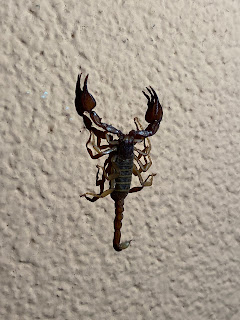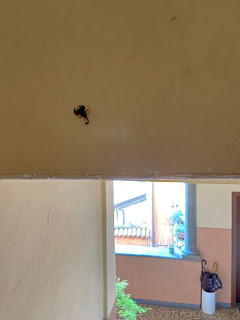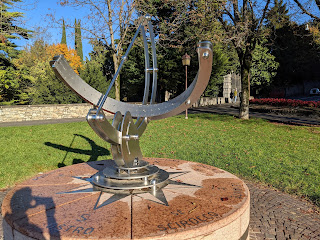Center: Wood-scorpion (Euscoporpius) in Bergamo on 2020-10-17.
I admit it, I thought scorpions only lived in the desert and had lethal stings. These statements contain a shred of truth but are far off from the full picture about scorpions. I had to come face to face with my scorpion ignorance recently when we ran into a scorpion on the wall of our palazzo.
My first question was: is it natural that there is a scorpion on the wall of our apartment building, in northern Italy? Has the world turned upside down? Has there been a mistake? No, no mistake, in fact scorpions are found on all landmasses except Antarctica. The most northern colony of scorpions in fact is on the Isle of Sheppey in the United Kingdom at 51 degrees N. They were accidentally introduced there.
We saw our first scorpion in Italy when we lived for several months in Florence in 2007. I remember being slightly disturbed when finding it under the sponge on our kitchen sink.
My second question was: are the scorpions we are running into in Italy dangerous? Again, the answer is no, not the type we are seeing (and pictured here). There are very dangerous types for sure but those are typically not found in Italy. And those dangerous types sting as last resort and do not actively seek out humans as prey! In other words, there is nothing to be afraid of from the ones we are seeing. In fact, the scorpions we typically see have a sting that has been described as mild as a mosquito bite to as bad as a bee sting. And again, they sting as a last resort.
My third question is what is the correct name for the scorpions we see? The scorpions we show here and see in Bergamo are in the genus Euscoporpius, commonly called small-wood scorpions. Distinguishing between species in the genus – according to this overview of scorpions in Italy – requires you to look at the underside of the claw of the scorpion and look at something called the trichobothria to be sure. (Not sure I will be doing that any time soon.)
By size, color, and prevalence, I’d say we are likely looking at E. italicus (in Italian), which is typically about 5cm (2 in) in size and found throughout Italy, Switzerland, France, Balkans, Greece and North Africa.
It’s said that scorpions with small pincers and a thick, powerful tail indicate a more potent sting. The idea behind this is that armed with a deadly venom the scorpion does not have to rely on its pincers as much to subdue its prey. In the photos here, the pincers are bigger than the tails.
Scorpions are in the class Arachnid, the class that contains spiders. And like spiders, scorpions eat other things like insects, spiders, and other scorpions. It is a cruel world. Of the over 1700 species of scorpion, only around 20 have venom lethal enough to kill a human and those are mostly or if not all in a different family Buthidae.
And so, I close with respect for our little scorpion friends we find on the walls of our apartment in Italy and all scorpions for that matter.


Left and center: Wood-scorpion in Bergamo 2021-12-09.
Right: Wood-scorpion in Bergamo hanging out in the stairwell 2021-12-12.






























